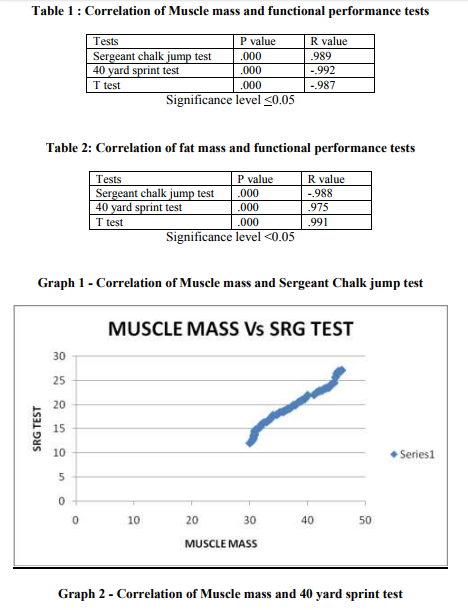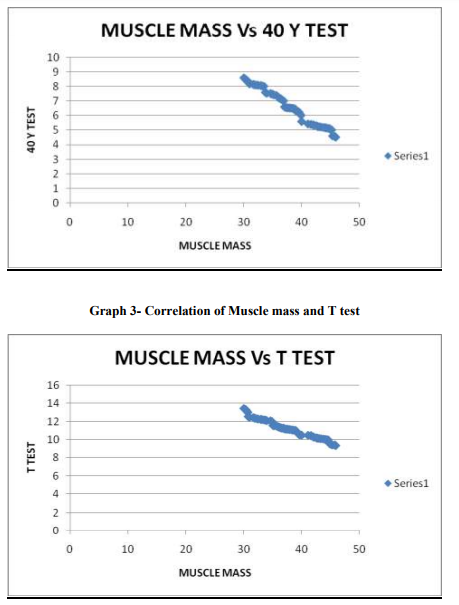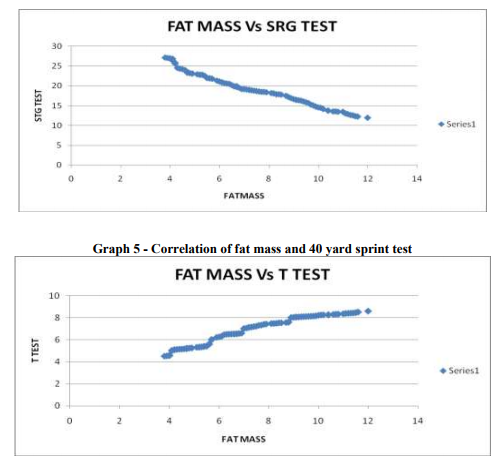IJCRR - 4(12), June, 2012
Pages: 111-117
Date of Publication: 22-Jun-2012
Print Article
Download XML Download PDF
ROLE OF FAT MASS AND MUSCLE MASS ON FUNCTIONAL PERFORMANCE OF ELITE INDIAN JUNIOR TENNIS PLAYERS
Author: Shibili Nuhmani, BN Pati, MD Abu Shaphe
Category: Healthcare
Abstract:Objective: To find out the correlation of fat mass and muscle mass with functional performance of elite Indian junior tennis players Design: Correlation design Setting: Tennis academies all over Delhi and National Capital Region Subjects: 100 elite Indian junior tennis players Measurement: The anthropometric data (fat mass and muscle mass) of each athlete has measured and has been correlated with all the three functional performance tests. Result and Conclusion: Pearson's correlation test was used to correlate the anthropometric data and functional performance test results. The study result showed that there was positive correlation exists between muscle mass and the entire three functional performance tests. At the same time there is an inverse correlation exist between fat mass and functional performance.
Keywords: anthropometry, functional performance, fat mass, muscle mass, junior tennis players
Full Text:
INTRODUCTION
Tennis is a world class competitive sport attracting millions of players and fans worldwide. It is the only major sports to be played on a variety of surfaces with different ball types and matches are played of best of three or five sets. Tennis is an immensely popular global sport with 205 nations affiliated to the international governing body, the international tennis federation (ITF) and over 25 million active players in USA alone. The general consensus on fitness development was that tennis players should incorporate flexibility, strength and endurance training in their programmes to minimise asymmetry and injuries, while simultaneously enhancing performance1 . It demands a complete physical conditioning program including exercises to develop flexibility, agility, cardio respiratory capacity, speed, strength, power and muscular endurance.2, 3 The interest in anthropometric characteristic and body composition of the players of different sports has increased over last decades. It has been well described that there are specific physical characteristics in many sports such as anthropometric profile that indicate whether the player would be suitable to compete the highest level in specific sports.4,5,6 Athletic performance is, to a large degree, dependent on the athlete's ability to sustain power (both anaerobic ally and aerobically) and to overcome resistance, or drag. Both of these factors are Interrelated with the athlete's body composition. Coupled with the common perception of many athletes who compete in sports where appearance is a concern for the athlete and the common perception of these athletes (swimming, diving, gymnastics, and figure skating), attainment of an ideal body composition often becomes a central theme of training. Besides the aesthetic and performance reasons for wanting to achieve an optimal body composition, there may also be safety reasons. During past two decades great changes have taken place in tennis with respect to technique and tactic, even more with respect to physical performance of the players. Most of the scientific literature has focus on physiological and biomechanical characteristic of the players. At present there is no data available regarding body composition and anthropometry of junior players of India and regarding their performance. There for the aim of this study was to find out how anthropometry andbody composition of elite Indian junior players influence their functional performance METHODS Subjects were recruited on the basis of voluntary participation through informed consent Subjects were recruited from different tennis academies all over Delhi and National Capital Region. Procedure The subjects from different tennis academies were being informed of the study. Subjects and their parents were informed about the nature, purpose, importance and possible risk of the study. Written parental or guardian consent were obtained before the players were permitted to participate. The research committee of the Singania University approved all the procedures. The subjects who match the criteria will be selected for the study. Anthropometric and body composition measurement will be taken for the entire subject. Instruction to the subject Subjects were refrained from strenuous exercise at least 48 hours prior to the testing and procedure and consume their normal pre training diet prior to the testing session Subjects were asked to report any discomfort during the session The subjects were asked for their full co operation and to do the procedures to their best of the ability. Protocol The entire protocol consist of 2 phases a. Pre-test measurement b. Protocol or intervention Pre test measurement included measurement of fat mass and muscle mass. Both muscle mass and Fat mass was measured by using Bio impedance analyser. The following functional performance tests were measured for each athlete after anthropometry. A. Sergeant chalk jump test B. 40 yard sprint test C. T test One minute of rest period was allowed between all functional performance tests7 . Three trials of functional performance test were performed with 30 seconds rest period between each trial7 . The best score from each functional performance test were taken from each test and recorded. RESULTS A total number of 100 elite Indian junior tennis players participated in the study. Mean age, height and weight of the athletes were 15.34+ 2.16, 170.54 + 5.43, and 65.36 +3.41 respectively. The anthropometric data (fat mass and muscle mass ) of each athlete has measured and has been correlated with all the three functional performance tests. The result of the study shows as follows Muscle mass and athletic performance The mean value of muscle mass was 37.32+ 5.09 The result shows that there is positive correlation exist between muscle mass and functional performance of the athletes (refer Table 1, graph 1,2,3) Fat mass and functional performance The mean value of fat mass was 8.055 + 5.7392 The result shows that there is negative correlation exist between fat mass and functional performance (refer Table 2, graph 4,5,6) DISCUSSION The purpose of the study was to find out the correlation between body composition (BMI and fat mass) and functional performance of Indian junior tennis players. A total number of 100 elite junior tennis players from different parts of the country participated in the study. The anthropometric data‘s like of each athlete has been measured and which has been correlated with the scores of different functional performance test scores of the athletes The result of the study showed that 1. There was a positive correlation exist between muscle mass and functional performance tests 2. There was an inverse correlation exist between fat mass and functional performance tests The result of the study indicated that there was an inverse correlation exists between body fat percentage and performance. Some of the previous studies have shown that the physical performance is negatively correlated with body fat and positively correlated with skeletal muscle mass16, 17. An excess subcutaneous adipose tissue means that greater muscular effort and therefore increased energy expenditure is required. In runners a high level of adipose tissue leads to a higher body weight and impairment of performance as more weight has to be moved, which does not contribute to the power development. In a recent study conducted by Arrese AL et al (2006)18 it has been noted that the loss of body fat is specific to the selected muscle group used during training and the race performance is enhanced with decreased skin fold thickness at lower limb. Body fat seems to have a special effect on African athlete‘s especially African runners. It was noticed in a study conducted by Bosch AN et al (1990)19 in study conducted among African athletes. They have a lower skin fold thickness at legs and arms suggesting a smaller mass of subcutaneous adipose tissue. But in other studies effect of body fat on race performance is controversial. Hagan et al20 found a positive correlation between performance time and body fat in female athletes where as Christensen and Ruhling21 found that percentage of body fat did not correlate with the performance. The study of Heltland et al22 demonstrated that regional and total body fat was inversely correlated with performance in treadmill test (-0.61 < r < -0.52, p < 0.0001). In runners decreased skin fold thickness in lower limb are measured after a longer training period, which may be particularly useful in predicting running performance23. In the study of Logos and Eston23 3 years of training has decreased the skin fold thickness and change in performance was related to the change in skin fold thickness of the triceps(r= -0.61,P = 0.001) , front of the thigh ( r = 0 . 74, P < .601) and medial calf(r = - 0.66,P<.001). Our present study is also in agreement with the study of GJ slator et al (2005)24 which states that successful lightweight rowers possess more muscle mass and less fat than their less successful counterparts. Leaner athletes with greater total muscle mass were more successful. CONCLUSION The study assessed the relationship of fat mass and muscle mass on functional performance correlation was found between fat mass and functional performance.
ACKNOWLEDGEMENTS
We thank Mr.Narsingh(Sr. Coach, All India Tennis Association ) and Mr.Vinod (DDA sports complex) for their support in conducting the study. The authors acknowledge the immense help received from the scholars whose articles are cited and included in the reference of this manuscript. The authors are also grateful to authors/editors/publishers of all those articles, journals and books from where the literature for this article has been reviewed and discussed.of elite Indian junior tennis players. A statistically significant positive correlation was found between muscle mass and functional performance, at the same time a negative
References:
1. Groppel JL, Robert EP. Applied physiology of tennis. Sports Med. 1992 Oct;14(4):260- 8.
2. T J Chandler 2000. ?Physiology of racket sports?. In Exercise and sport science, 905– 917. Philadelphia, PA: Lippincott Williams and Williams.
3. Groppel J and Roetert. E. P 1992. Applied physiology of tennis. Sports Medicine, 14: 260–268
4. T. Reilly, J. bangsbo A. Franks. Anthropometric and physiological predispositions for elite soccer. Journal of Sports Sciences, 2000, 18, 669-683
5. T.R. Ackland , K.B. Ong , D.A. Kerr, B. Ridge. Morphological characteristics of Olympic sprint canoe and kayak paddlers. Journal of Science and medicine in sports . Volume 6 , issue 3 September 2003, 285- 294
6. Jan Bourgois, Albrecht L. Claessens, Melissa Janssens, Bart Van Renterghem, Ruth Loos, Martine Thomis, Renaat Philippaerts, Johan Lefevre and Jacques Vrijen . Anthropometric characteristics of elite female junior rowers. Journal of Sports Sciences, 2001, 19, 195-202
7. Todd A E vans,Christopher Ingersoll,Kenneth L Knight,Teddy Worrel. Agilty following the application of cold therapy. J Athl Train. 1995 September; 30(3): 231–234..
8. HE Leedy, AH Ismail, WV Kessle. Relationships between physical performance items and body composition. Research quarterly, 1965 ,36:158-63
9. Riedenau RP, Welch BE,Crips CE et al . Relationship of body fat to motor fitness test scores. Research quarterly,1968,29:200-3
10. Alejandro L arrese and Enrique S . Ostariz .Skin fold thicknesses associated with distance running performance in highly trained runners. Journal of Sports Sciences. Volume, issue 1 , 2006
11. Andrew N Bosch, Brian r Goslin , Timothy D Noakes and Steven c . Dennis Physiological differences between black and white runners during a treadmill marathon. European journal of applied physiology and occupational physiology . volume 61, number 1-2, 68-72
12. R D Hagan, S J Upton, J J Duncan, L R Gettman. Marathon performance in relation to maximal aerobic power and training indices in female distance runners. Br J Sports Med 1987;21:3-7
13. C.L.Christensen, R.O.Ruhling.Physical cha racteristics of novice and experienced wom en marathon runners. Br J Sports Med 1983;17:166-171
14. M. L. Hetland, J. Haarbo, C. Christiansen. Regional body composition determined by dual-energy x-ray absorptiometry. Relation to Training, Sex Hormones, and serum lipids in male long-distance runners. Scandinavian Journal of Medicine and Science in Sports.Vol.8 Issue .2 pages 102– 108, April 1998
15. A Legaz, R Eston. Changes in performance, skin fold thickness and fat patterning after three years of intense athletic conditioning in high level runners. Br J Sports Med 2005;39:851-856
16. G J Slater, A J Rice, I Mujika, A G Hahn, K Sharpe, D G Jenkins. Physique traits of lightweight rowers and their relationship to competitive success. Br J Sports Med 2005;39:736-74



|






 This work is licensed under a Creative Commons Attribution-NonCommercial 4.0 International License
This work is licensed under a Creative Commons Attribution-NonCommercial 4.0 International License